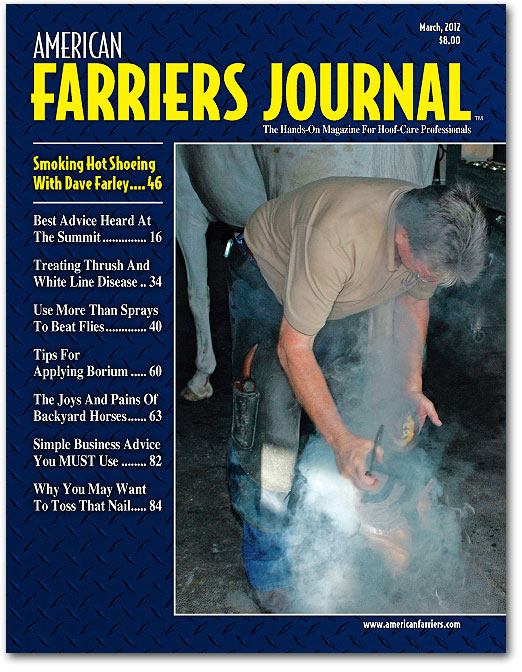Millwater's Farriery:
The Illustrated Dictionary of Horseshoeing and Hoofcare:
Encyclopedic Reference for Professionals, Students, and Horseowners.
The encyclopedic dictionary of the art and science of farriery, designed for cross-referencing. Well illustrated with appendices of full-page illustrations, historical reference material, and resource guides.
This is the culmination of out farriery lexicon project started in 1994.
Paperback $22.50 Hardcover $36.50 Kindle eBook $9.95
https://www.amazon.com/dp/1466444819/

Shoe Your Own Damned Horse!
SYODH! is comprehensive but good-humored primer for horse owners who want (or need) to learn how to trim or shoe their own animals, written by a veteran professional farrier and horseman.
The Illustrated Dictionary of Horseshoeing and Hoofcare:
Encyclopedic Reference for Professionals, Students, and Horseowners.
The encyclopedic dictionary of the art and science of farriery, designed for cross-referencing. Well illustrated with appendices of full-page illustrations, historical reference material, and resource guides.
This is the culmination of out farriery lexicon project started in 1994.
Paperback $22.50 Hardcover $36.50 Kindle eBook $9.95
https://www.amazon.com/dp/1466444819/

Shoe Your Own Damned Horse!
SYODH! is comprehensive but good-humored primer for horse owners who want (or need) to learn how to trim or shoe their own animals, written by a veteran professional farrier and horseman.
Well
illustrated, and with emphasis on practical economy.
Sections on hoof and limb anatomy, essential biomechanics, hoof handling, trimming for barefoot, tools and their functions, horseshoe choice/modification and application, cold and hot shoeing, managing common faults and pathologies, and even how to build a forge. Lots of practical, insider hints sprinkled throughout.
Paperback $9.95
https://www.amazon.com/Shoe-Your-Own-Damned-Horse/dp/B0DGF3CZVD

The New Dictionary of Farrier Terms and Technical Language.
The 9th and final "New Dictionary" of the series before the jump to MILLWATER'S FARRIERY.
Paperback $18.12
https://www.amazon.com/Dictionary-Farrier-Terms-Technical-Language/dp/1449594689/

The New Dictionary of Farrier Terms and Technical Language.
The tenth anniversary edition, coil-bound, no-less. For the completionists out there.
Coil bound $13.42
https://www.lulu.com/shop/dave-millwater/new-dictionary-of-farrier-terms/paperback/product-1k9gr6.html

MILLWATER'S FARRIERY:
Deluxe Hardcover.
The AMAZON hardcover is a bit less expensive, and pretty nice. But, as of the production of my proof copies, the LULU production quality was a little better. (Amazon's hardcover printing might have improved, it was in beta then.) Though they did manage a humorous SNAFU by sending me one copy with our cover wrapped around a completely unrelated book. They make good on such errors quickly though.
Hardcover $50.00
https://www.lulu.com/shop/dave-millwater/millwaters-farriery-the-illustrated-dictionary-of-horseshoeing-and-hoofcare/hardcover/product-1wzpq4rz.html
===================================================
Guild of Professional Farriers Publications.
Note: URLs an mail addresses in these old publications are out of date.

Registered Journeyman Farrier Exam Guide
Sections on hoof and limb anatomy, essential biomechanics, hoof handling, trimming for barefoot, tools and their functions, horseshoe choice/modification and application, cold and hot shoeing, managing common faults and pathologies, and even how to build a forge. Lots of practical, insider hints sprinkled throughout.
Paperback $9.95
https://www.amazon.com/Shoe-Your-Own-Damned-Horse/dp/B0DGF3CZVD

The New Dictionary of Farrier Terms and Technical Language.
The 9th and final "New Dictionary" of the series before the jump to MILLWATER'S FARRIERY.
Paperback $18.12
https://www.amazon.com/Dictionary-Farrier-Terms-Technical-Language/dp/1449594689/

The New Dictionary of Farrier Terms and Technical Language.
The tenth anniversary edition, coil-bound, no-less. For the completionists out there.
Coil bound $13.42
https://www.lulu.com/shop/dave-millwater/new-dictionary-of-farrier-terms/paperback/product-1k9gr6.html

MILLWATER'S FARRIERY:
Deluxe Hardcover.
The AMAZON hardcover is a bit less expensive, and pretty nice. But, as of the production of my proof copies, the LULU production quality was a little better. (Amazon's hardcover printing might have improved, it was in beta then.) Though they did manage a humorous SNAFU by sending me one copy with our cover wrapped around a completely unrelated book. They make good on such errors quickly though.
Hardcover $50.00
https://www.lulu.com/shop/dave-millwater/millwaters-farriery-the-illustrated-dictionary-of-horseshoeing-and-hoofcare/hardcover/product-1wzpq4rz.html
===================================================
Guild of Professional Farriers Publications.
The Guild has been dormant for some time now, but was an
influential player in American farriery in the '90s and first part
of this century. These booklets are maintained for historical
reference. The .PDF downloads are free. (Sorry about the hassle of
checkout. That's the PoD service's hang-up.) The printed versions
are at the PoD production cost.
Note: URLs an mail addresses in these old publications are out of date.

Registered Journeyman Farrier Exam Guide
$4.72 Paperback
https://www.lulu.com/shop/dave-millwater/rjf-exam-guide/paperback/product-1zdrpk.html
Free Download
https://www.lulu.com/shop/dave-millwater/rjf-exam-guide/ebook/product-1rgy5d8v.html
New Guild Chronicle #1
https://www.lulu.com/shop/dave-millwater/rjf-exam-guide/paperback/product-1zdrpk.html
Free Download
https://www.lulu.com/shop/dave-millwater/rjf-exam-guide/ebook/product-1rgy5d8v.html
New Guild Chronicle #1
Includes the content of the RJF Exam Guide, other Guild material, and articles from Guild President Henry Heymering on the Strasser barefoot trim fad and weight-bearing mechanisms of the hoof.
$7.53 Coil bound
https://www.lulu.com/shop/dave-millwater/guild-chronicle/paperback/product-1jzpw6.html
Free Download
https://www.lulu.com/shop/dave-millwater/guild-chronicle/ebook/product-1qzp6zjn.html
New Guild Chronicle #2
$7.53 Coil bound
https://www.lulu.com/shop/dave-millwater/guild-chronicle/paperback/product-1jzpw6.html
Free Download
https://www.lulu.com/shop/dave-millwater/guild-chronicle/ebook/product-1qzp6zjn.html
New Guild Chronicle #2
Includes the Guild's constitution and bylaws as they stood in 2005.
$5.88 Paperback
https://www.lulu.com/shop/dave-millwater/new-guild-chronicle-2/paperback/product-1qvwjr.html
Free Download
https://www.lulu.com/shop/dave-millwater/new-guild-chronicle-2/ebook/product-1gv6rnwd.html
$5.88 Paperback
https://www.lulu.com/shop/dave-millwater/new-guild-chronicle-2/paperback/product-1qvwjr.html
Free Download
https://www.lulu.com/shop/dave-millwater/new-guild-chronicle-2/ebook/product-1gv6rnwd.html
. . .
-30-


























